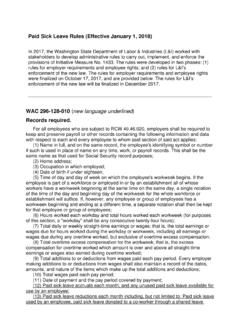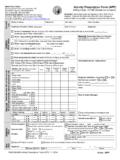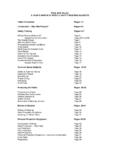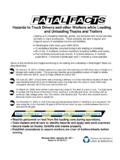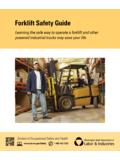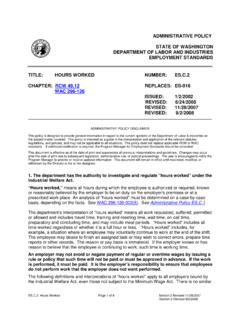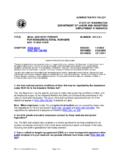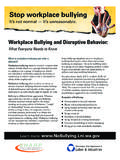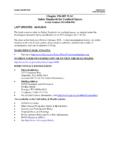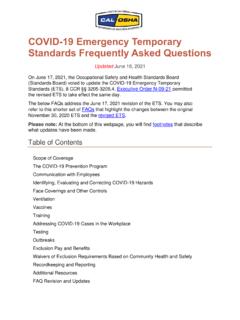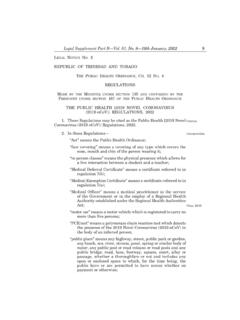Transcription of F414-164-000 L&I Requirements and Guidance for Preventing ...
1 Division of Occupational Safety and 1-800-423-7233L&I Requirements and Guidance for Preventing COVID-19 This information is current as of Sept. 13, are required to follow face covering Requirements as provided in the governor s Proclamation and in accordance with the Secretary of Health s Order for Employers in Public SpacesEmployers must maintain a safe, COVID-free work environment by: Requiring face coverings or masks for customers and employees, in all industries, regardless of vaccination status, in indoor spaces accessible to the public and at outdoor events or gatherings attended by 500 or more people.
2 Posting signage in a prominent location visible to customers at each entry informing customers of the face covering requirement. Providing cloth face coverings or a more protective mask to employees, free of charge, when use of a mask is required or requested. Keeping employees with possible or confirmed cases of COVID-19 from working around others and following appropriate isolation or quarantine Guidance as required. Providing handwashing facilities and supplies. Training employees to recognize and respond to workplace hazards, including COVID-19.
3 Assessing recognized hazards, including COVID-19, as part of the ongoing requirement to provide a safe and healthful workplace and, where appropriate, taking additional steps to protect all employees. Providing written notice of potential exposure within one business day to all employees, and the employers of subcontracted employees, who were at the same worksite as a person who tested positive for COVID-19 (without disclosing the person s identity.) Reporting COVID-19 outbreaks of 10 or more employees at a workplace or worksite with more than 50 employees to L&I within one business for Employers in Non-Public Spaces In areas that are not accessible to the public, employers may allow fully vaccinated employees, whose status has been verified by the employer, to remove their face covering or mask while indoors.
4 In addition, a person working alone may also remove their face covering , regardless of vaccination status. A person is working alone if they are isolated from interactions with others and have little or no expectation of in-person interruptions. Examples include: -A sole occupant in an office with a closed door who is unlikely to be visited. -A tractor driver or crane operator isolated in an enclosed cab. -Delivery drivers with no face-to-face interaction with others when picking up or dropping off packages.
5 -A lone janitor in a building. Employers may also choose to require fully vaccinated workers to wear face coverings even in spaces not accessible to the public. Employees have the right to voluntarily wear a mask or other protective equipment when it s not required-as long as use doesn t create a safety or security issue. All other Requirements not related to face coverings including training, cleaning, hazard assessment, notification and other Requirements continue to apply in non-public Worker Vaccination StatusAny employer choosing to allow fully vaccinated employees to work without a mask in non-public indoor spaces must verify employee vaccination status.
6 Employers must be able to show the process used to verify employee vaccination status. However, they are not required to keep an actual copy of the employee s vaccination types of verification include: Vaccine card or photo of vaccine card. Documentation from a health care provider. State immunization information system record. A hard copy or electronically signed self-attestation from the employee . Note: Self-attestation is not an acceptable verification option for state agencies, schools, or health care settings.
7 Further, private employers are not required to offer self-attestation as a verification implementing a verification process, employers should consider other laws that may Guidance for Protecting WorkersThe following information is advisory and intended to help employers provide a safe and healthy workplace. However, there may be specific Requirements that must be followed for certain tasks with high risk of transmission. A COVID-19 vaccine is the best tool to prevent the spread of the virus. For workplaces where vaccination isn t required, employers should support and encourage workers to get vaccinated.
8 Other ways to reduce the risk of COVID-19 transmission for employees include: -Continuing distancing between unvaccinated employees, especially in indoor areas with poor ventilation or while working with the public. -Maximizing fresh air and air filtration settings on HVAC systems, and adding filtration in areas with poor ventilation. -Providing a mask to workers outdoors in crowded settings with fewer than 500 people is strongly encouraged ( sporting events, fairs, parades, concerts, and similar settings).
9 -Providing a mask that is more protective than a cloth face covering for workers who are not able to maintain distance from others or who are at greater risk for transmission. Examples could include surgical masks , KN95s, and in certain situations, Accommodation and DiscriminationEmployers must ensure workplaces remain safe and healthy for all, including employees with medical issues or disabilities (see the Americans with Disabilities Act, or ADA, at ).Additionally, state law protects high-risk employees from being discharged, permanently replaced, or discriminated against in the workplace for seeking accommodation from exposure to an infectious or contagious disease during a public health emergency.
10 This law is administered by L&I and currently applies to accommodations related to & I s Which Mask for Which Task? has information about exposure risk and mask selection: s COVID-19 Guidance includes resources from the Centers for Disease Control (CDC), Department of Health (DOH) and Occupational Safety and Health Administration: Secretary of Health s face covering order, with details of the Requirements and exceptions: a COVID-19 violation: request, foreign language support and formats for persons with disabilities are available.

